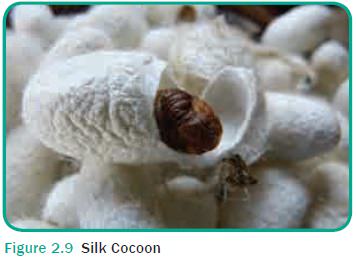Natural Fibres | Textiles - Silk Fibre | 11th Textiles and Dress Designing : Chapter 2 : Natural Fibres
Chapter: 11th Textiles and Dress Designing : Chapter 2 : Natural Fibres
Silk Fibre
SILK
Silk is commonly known as the “Queen of Fabric”.
It is a very fine long smooth protein fibre. It is a secretion of silkworm.
Silk was first found by the Chinese Princess and after many years the technique
was passed on to other countries. Silk can be cultivated or it is found in forests
as wild silk. Cultivated silk variety is the Mulberry silk. The common wild
silk varieties are Eri, Tasar and Muga silk. The process of cultivation of
silkworm for silk production is called as sericulture.
Principle Origin : Natural
Generic Name : Proteinaceous
Chemical : Secretion of silk worm
Common Name : Silk
Production of Silk
The production of silk involves many sub
division,
·
Sericulture.
·
Silkworm egg hatching.
·
Feeding the silkworm.
·
Spinning silk thread from cocoon.
·
Silk filament reeling.
·
Silk throwing.
·
Weighting of silk.
Sericulture
Sericulture is a process in which silkworms are
cultivated. Bombyx mori is the species used by most of the commercial silk
indus-try. Silk worms are fed with mulberry leaves. Therefore mulberry trees
are grown. The mulberry leaves are cut into small parts and given as feed to
silk worms.
Egg Hatching
As per modern scientific methods, eggs are
produced for fertilization from mul-berry silkworms. The produced eggs are
collected and stored under suitable con-ditions so that it will be used
whenever it is needed.
Feeding the Silkworm
The collected eggs are kept in the incu-bator for
hatching at 18°C to 28°C. Heat is required for hatching of the eggs, which
takes about one week to 10 days. Eggs are hatched into larva or caterpil-lars
of quarter inch lag. The tiny hatched worms are kept with the mulberry leaves
in a plate. Care is taken to feed the worms at regular intervals. After eating
more and more leaves, the worm becomes bigger in size of 3 inches. After the
full growth, it stops eating and there is change in colour of the silkworm. It
takes approximately one month for the silk worm to achieve the full growth. The
fully grown worm swings its head and secretes a substance from the ends of its
mouth, and the secreted substance solidifies on contact with air. Using this
substance the silk worm forms a cocoon around its body. This substance is a
con-tinuous, thin filament made of sericin and fiberoin. The silkworm takes two
to three days for formation of the cocoon. The well grown cocoons are selected
for the fertilization and the others are used for the making of silk fibre.
Cocoons are put in hot chamber and steam is passed. This process is called
staving or stifling to destroy chrysalis inside the cocoon. This process would
prevent silk filament breakage (Figure 2.8).

Spinning Silk Thread from Cocoon
The cocoons (Figure 2.9) are put in hot water, so
that the gum on the outer shell is removed. After that, using a stick the loose
fibres is slowly unreeled.

Silk Filament Reeling
It is passed through an eyelet and reeled on to a
wheel. The fibres are moved from left to right hand slowly and rolled up. This
pro-cess is called reeling. Three to ten fibres are combined to make a suitable
silk filament.
Throwing
The reeled silk is known as raw silk. The process
of transferring silk fibre to yarn is known as throwing. This is sorted based
upon size, colour, length or quantity. The raw silk skeins are soaked in warm
water with soap or oil. This softens the sericin and helps in the movement of
the threads. The skeins are placed on light reels and the silk is wound on the
bobbins after mechanical drying. When the strands are wound, desired amount of
twist can be given. If two or more yarns are wound it is called doubling. Based
on the require-ments the twist may be given in the same or opposite direction.
In order to make yarns into fabrics, the yarns are dyed first. The yarns are
washed with soap water to remove sericin. This process is called degumming. The
silk filaments are reeled into skeins. This is packed into small bun-dles
called books, which is kept ready for marketing.
Weighing of Silk
The silk fabric manufactures buy silk yarns in
kilograms for cloth production. During degumming process the silk weight is
lost. In order to increase the weight of silk which was lost in degumming the
silk yarns are treated with chemical and metals. This process increases the
weight of fabric and is called weighting of silk. This processes increase the
weight of the silk but the natu-ral elasticity is lost.
The silk also gets deteriorated on exposure to
sunlight, perspiration and dry cleaning.
Characteristics of the Silk Fibre
Shape : Like glass rod
Length : 30,000 – 39,000 cm
Elasticity : More
Stretch ability : More
Flexibility : Medium
Density : 1.25 g/cm3
Reaction : Causes less damage with acid
To flame : Burns with a sputtering flame
Sunlight : Increased exposures will breakdown the fibres
Insects : Destroyed by carpet beetles
Drying : Quick and good
Dyeing : Good absorption for acid and basic dyes
Common Uses of Silk
·
Clothing (Scarfs, Silk Sari, Dothi, Towel, Dress
Materials).
·
Household textiles (Bed Spread, Wall Hangers, Table
Cloths).
· Medical Textiles (Suture Threads).
Related Topics